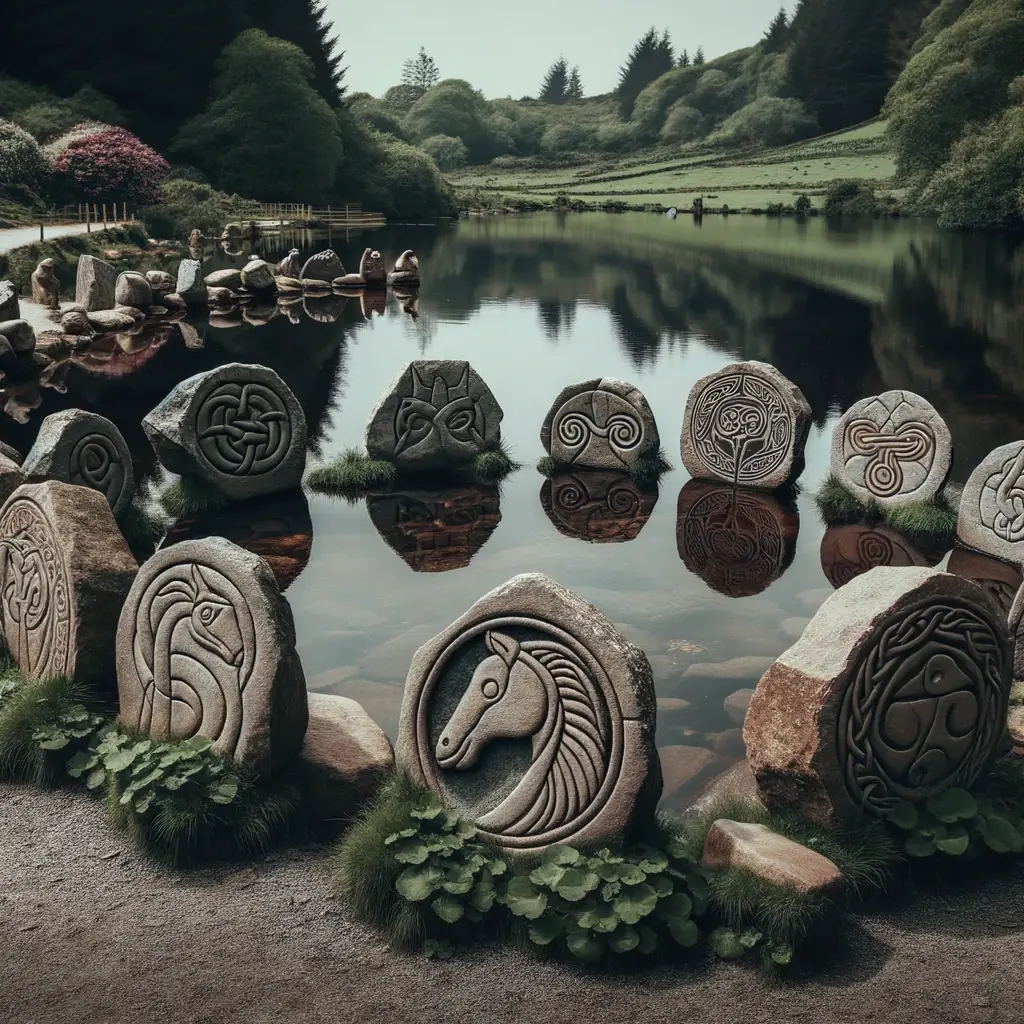Symbolism and Meaning
Celtic animal symbols are rich in symbolism and meaning. The ancient Celts believed that animals possessed special qualities and characteristics that could be used to represent different aspects of life. These animal symbols were often used in Celtic art, jewelry, and other forms of decoration.
One of the most common animal symbols in Celtic art is the Celtic knot, which represents the interconnectedness of all things. Other animal symbols include the stag, which represents strength and power, the fox which represents cunningness, as well as birds like the swan, which represents love and beauty.
The Celtic Tree of Life is another important symbol in Celtic culture. It represents the interconnectedness of all living things and the cyclical nature of life. The roots of the tree represent the past, the trunk represents the present, and the branches represent the future.
Many animals were also associated with specific qualities and characteristics. For example, the snake was associated with rebirth, fertility, and healing, while the horse was associated with courage, inspiration, and transformation.
With that out of the way, let’s explore Celtic animal symbols and meanings!
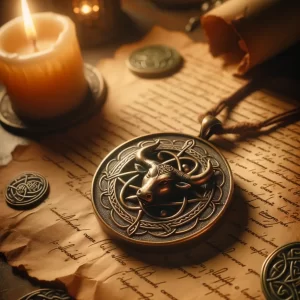
Celtic Animals in Druidic Culture
Celtic Shamanism and Druidism have long been associated with the use of animal symbols to convey knowledge, myst, and myth. These animals were believed to have a connection to the Otherworld and were used as a symbolic language to communicate with the spirits.
The Celts believed that each animal had its own unique qualities and characteristics that could be used to convey specific messages. They used these animals as totems, or Celtic spirit animals, to guide them through life and help them connect with the spiritual realm.
Some of the animals denoted by Celtic Shamanism and Druidism along with their spiritual denotation are:
| Animal | Spiritual Denotation |
|---|---|
| Adder, Snake (Nadredd) | Wisdom, Reincarnation, and Cunning |
| Raven (Bran) | Magic, Prophecy, and Protection |
| Stag (Damh) | Strength, Independence, and Pride |
| Salmon (Bradán) | Wisdom, Inspiration, and Knowledge |
| Horse (Each) | Freedom, Power, and Grace |
| Boar (Torc) | Courage, Tenacity, and Ferocity |
| Fox (Sionnach) | Cleverness, Trickery, and Adaptability |
| Bear (Art) | Strength, Protection, and Healing |
The Celts also used the Celtic Ogham, a symbolic language consisting of 25 letters, to convey messages and communicate with the spirits. Each letter was associated with a tree, which was in turn associated with an animal. For example, the letter “D” was associated with the Oak tree, which was in turn associated with the Stag.
In Druidic culture, animals were also used as symbols to represent certain virtues or qualities. For example, the Raven was seen as a symbol of wisdom, the Salmon as a symbol of knowledge, and the Boar as a symbol of courage.
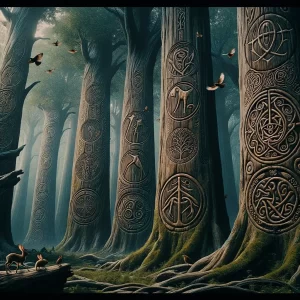
Celtic Animal Symbols in Mythology
Celtic animal symbols have a rich history in mythology. Animals were believed to have a special connection to the Otherworld, which is a realm beyond the physical world. The Celts believed that animals were messengers from the Otherworld and could bring them secrets and messages from the gods.
In Celtic mythology, animals were often associated with goddesses. For example, the goddess Brigid was often depicted with a cow, which was a symbol of fertility and abundance. The goddess Epona was associated with horses and was believed to protect horses and riders.
The Celts also believed that animals could help them access the Otherworld. For example, the crane was believed to be able to fly between the worlds and was a symbol of transformation and change. The snake was also associated with the Otherworld and was believed to have the power to heal and transform.
Some animals were also seen as protectors of the land. The bull was a symbol of strength and power and was often associated with the god Cernunnos, who was the guardian of the forest. The stag was also a symbol of the forest and was believed to have the power to bring abundance and prosperity.
The Role of Animals in Celtic Warfare
Animals played a significant role in Celtic warfare, both as companions and symbols. Horses were the most common animal symbols used by Celtic noblemen in battle, known for their beauty, speed, vitality, and fertility. Celtic horses symbolized development, healing, rejuvenation, and life in motion.
In addition to horses, other animals were also used in Celtic warfare. Dogs were used as protectors and guards, while birds such as ravens and eagles were used as symbols of power and protection. Celtic warriors also wore animal skins and furs to intimidate their enemies and to show their connection to nature.
Celtic warriors believed that animals had spiritual powers and that they could draw strength and protection from them. They would often paint or tattoo animal symbols on their bodies before going into battle. These symbols were believed to give them courage, strength, and protection.
Celtic mythology is also full of animals that played important roles in battle. For example, the Morrigan, a goddess of war, was often depicted as a crow or raven. She would fly over the battlefield, inspiring and protecting the Celtic warriors.

Celtic Animals and the Elements
Celtic animal symbolism is deeply intertwined with nature and the elements. The Celts believed that everything in the natural world was interconnected and that animals were powerful spiritual beings that could help them connect with the divine.
One of the most important elements in Celtic mythology is the earth. The Celts believed that the earth was a living entity that was connected to all other living things. Animals were seen as guardians of the earth, and many Celtic animal symbols are associated with the earth element.
The oak tree was especially important to the Celts, and it was seen as a symbol of strength and endurance. The oak tree was also associated with the earth element and was often used in Celtic art and architecture.
Other plants and trees were also important to the Celts, and many Celtic animal symbols are associated with them. For example, the Celtic tree of life is a symbol of the interconnectedness of all living things, and many animals are depicted in Celtic art alongside trees and plants.
In addition to the earth element, Celtic animal symbols are also associated with the other elements, including fire, water, and air. For example, the dragon is a powerful symbol of fire, while the salmon is associated with water. The eagle, on the other hand, is a symbol of air and is often depicted soaring high in the sky.
Specific Celtic Animal Symbols
The Stag and Doe
The stag and doe are both important symbols in Celtic culture. The stag represents masculinity, strength, and nobility, while the doe represents femininity, grace, and gentleness. The antlers of the stag are also a symbol of connection to the spiritual realm, as they reach towards the heavens.
The Bull
The bull is a symbol of fertility, strength, and power. In Celtic mythology, the bull was often associated with the god of the underworld and was seen as a symbol of mystery and the unknown.
The Cat
The cat is a symbol of agility, independence, and mystery. In Celtic culture, cats were often seen as protectors of the home and were believed to have the ability to see into the spiritual realm.
The Crow and Raven
The crow and raven are both symbols of intelligence and mystery. In Celtic mythology, the crow was often associated with the goddess of war and was seen as a symbol of hunting and victory.
The Salmon
The salmon is a symbol of wisdom and knowledge. In Celtic mythology, the salmon was believed to possess the wisdom of the ages and was often associated with the sacred wells of knowledge.
The Horse
The horse is a symbol of loyalty, nobility, and freedom. In Celtic culture, horses were highly prized and were often associated with the gods and goddesses. They were also seen as symbols of transcendence and were believed to have the ability to travel between the spiritual and physical realms.
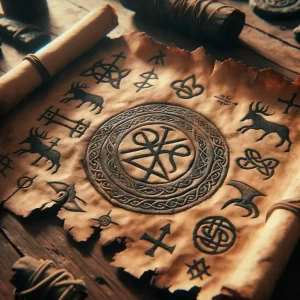
The Eagle
The eagle is a symbol of strength, courage, and freedom. In Celtic mythology, the eagle was often associated with the sun and was seen as a symbol of power and victory.
The Wolf
The wolf is a symbol of loyalty, family, and protection. In Celtic culture, wolves were often seen as protectors of the home and were believed to have the ability to see into the spiritual realm.
The Dragon
The dragon is a symbol of power, wisdom, and mystery. In Celtic mythology, the dragon was often associated with the elements and was seen as a symbol of transformation and change.
The Butterfly
The butterfly is a symbol of transformation, beauty, and rebirth. In Celtic culture, butterflies were often seen as messengers from the spiritual realm and were believed to have the ability to guide people through times of change and transformation.
Interpreting Celtic Animal Symbols
Celtic animal symbols are a fascinating and complex aspect of Celtic culture. Understanding the meanings behind these symbols can be a helpful guide for personal growth and learning.
Interpreting Celtic animal symbols requires a guide to understanding the animal’s characteristics and how they relate to human behavior. For example, the Celtic horse symbolizes freedom, power, and strength. By encountering this symbol, one may be encouraged to embrace their own inner strength and power.
Learning the meanings behind Celtic animal symbols can also help individuals understand their encounters with these animals in real life. For instance, if someone encounters a Celtic fox symbol, they may be reminded of the fox’s cunning and adaptability, encouraging them to be more resourceful in their own life.
Interpreting Celtic animal symbols can also provide insight into the spiritual and emotional aspects of life. The Celtic butterfly symbolizes transformation and rebirth, reminding individuals that change can be a positive and transformative experience.
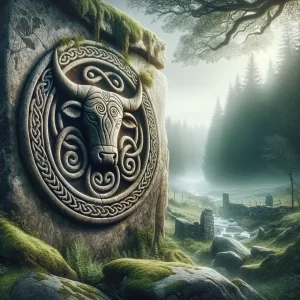
Frequently Asked Questions
What animals are sacred to the Celts?
Celts considered animals to be sacred beings that held significant importance in their culture. Among the animals that were considered sacred to the Celts were the horse, boar, raven, stag, and salmon. These animals were often depicted in Celtic art and mythology.
What animal represents Celtic?
The animal that represents the Celtic culture is the Celtic boar. The Celtic boar symbolizes strength, courage, and fertility. It was considered a sacred animal by the Celts and was often depicted in their art and mythology.
How do you know your Celtic animal?
The Celts believed that each person had a spirit animal that represented their personality and traits. To know your Celtic animal, you can take a Celtic animal zodiac quiz or consult a Celtic astrology expert. The animal that corresponds to your birth date is believed to be your Celtic animal.
What is the Celtic animal for strength?
The Celtic animal that represents strength is the bear. The bear symbolizes power, courage, and protection. It was considered a sacred animal by the Celts and was often depicted in their art and mythology.
What is the significance of Celtic animal designs?
Celtic animal designs are significant because they represent the connection between humans and nature. They were used to convey messages and meanings in Celtic art and were believed to have mystical powers. Each animal had its own symbolism and meaning in Celtic culture.
What are some common Celtic bird symbols?
Birds were an important part of Celtic culture and were often depicted in their art and mythology. Some common Celtic bird symbols include the raven, which symbolizes death and rebirth, the swan, which represents grace and purity, and the eagle, which symbolizes strength and courage.
What is the sacred animal of the Irish?
The Irish have a deep-rooted cultural and spiritual connection to various animals. Among them, the most sacred is often considered to be the salmon. The salmon holds a special place in Irish mythology, especially in tales where it is seen as the bearer of knowledge and wisdom.
What does each animal symbolize?
In Celtic and Irish traditions, different animals have various symbolic meanings:
- Stag/Deer: Symbolizes spirituality, purity, and renewal.
- Salmon: Represents wisdom, knowledge, and inspiration.
- Raven: Often seen as a messenger from the otherworld, representing magic and transformation.
- Horse: Symbolizes strength, sovereignty, and travel between worlds.
- Hound: Represents loyalty, courage, and tracking skills. (Note: The symbolism can vary based on different tales and regions.)
What is the Celtic animal of healing?
The serpent or snake is often associated with healing and rebirth in Celtic traditions. It is believed that the snake has the power to rejuvenate its body by shedding its skin, symbolizing the cycle of life, death, and rebirth. Additionally, the Druids, who were the spiritual leaders in ancient Celtic cultures, often used snake symbols in their healing rituals.
To learn more about Celtic symbols, check out this video below:

